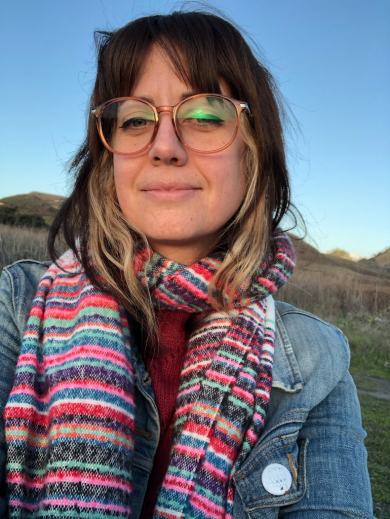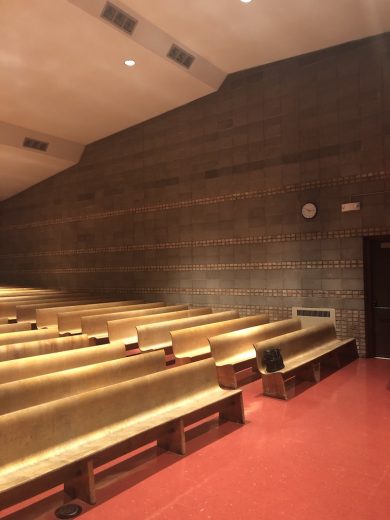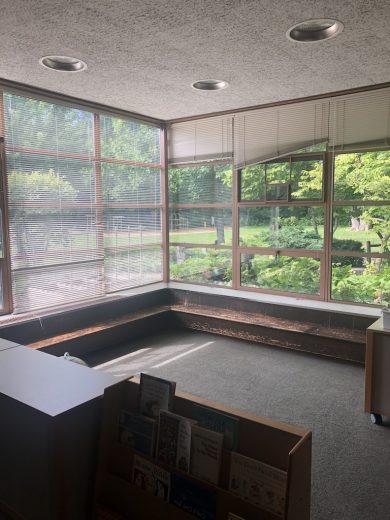Graduate Profile: Leslie Lodwick, History of Art and Visual Culture Doctoral Student

Leslie Lodwick is a PhD Student in the History of Arts and Visual Culture (HAVC) Department at UC Santa Cruz. Lodwick is a scholar of architectural history, education, and the built environment of the United States. Since beginning her time with HAVC, she has been a UC Santa Cruz SSRC-Dissertation Proposal Development Fellow and a THI Graduate Student Success Peer Mentor.
In November, we spoke with Lodwick about her research interests, the unique HAVC program of study, and her experience as a THI fellow. Our discussion focused on the visual and material cultures of childhood, working across a constellation of academic disciplines, and what’s at stake in Lodwick’s work in the current moment.
Thanks for speaking with us Leslie! To help ground our conversation, would you mind just telling us in broad strokes about your work and research interests? How do you think about your scholarship?

Thank you so much for the opportunity! Broadly, my research looks at architectural spaces of schooling and education, especially public education, and their interactions with educational policy, municipal planning, knowledge production, as well as environmental and technological histories. I am also interested in the visual and material cultures of childhood, play, and imagination. I hope that my scholarship contributes to and extends conversations about the role of space and the built environment in educational discourses. It is also my hope that through interrogating the role of the student as architectural user, this scholarship can help highlight how we might think more holistically about what children need and want from architectural spaces in order to grow, develop, learn and contribute a distinct voice and perspective to society. I really see myself as a visual historian of architecture and education as they are intertwined.
The History of Arts and Visual Culture Department is such a unique and innovative intellectual space. How has the chance to be a part of it influenced your work? Has your focus shifted since you arrived at UC Santa Cruz?
This department is definitely a unique place. Visual studies is defining itself as a field both in, along with and outside of art history, so it’s a special moment to be a part of the field as it reckons with itself and defines its own shape-shifting contours. Visual studies is concerned with not only visuality/the visual as a method through which to understand big social, political, economic and environmental ideas (etc.), but also, I think, with examining the ways that the visual, as an embodied experience, has organized certain histories through art and visual culture. The HAVC department at UCSC is comprised of a group of scholars with an array of spatio-temporal specializations but we all come together around some of these questions of seeing and visuality in order to elucidate discourses around the way we socially see, are seen, and represent. Through being a part of HAVC, my own thinking has truly been influenced by all the students and faculty I’ve had the privilege of working with in my time here. I’ve long been interested in the ways that school buildings express certain priorities and anxieties but contextualizing this work with other areas of visual culture including planning, advertisements, and contemporary art, to name a few, through interactions with the HAVC network, hopefully, my research will contribute to these conversations in multiple disciplines in a more robust and provocative way.
Coupled with site visits to a number of modern public schools built during the 1930s and early 1940s and interviews with local historians, teachers and administrators, my summer research became the foundation on which to build my present dissertation research.
Last year you were a fellow in the UC Santa Cruz SSRC-Dissertation Development Program. Can you tell us a bit about your experience in this program? What did you find most generative about it?
My experience with the SSRC-DPD program was beneficial to my dissertation research and to my growth as a scholar more generally. Through the program, I was able to visit a number of architectural archives whose contents allowed a deeper understanding of early twentieth-century school-building projects through letters, planning materials, blueprints, doodles, drawings, advertisements photographs, and policies. Coupled with site visits to a number of modern public schools built during the 1930s and early 1940s and interviews with local historians, teachers and administrators, my summer research became the foundation on which to build my present dissertation research. As an architectural historian, having firsthand access to feel the rooms and exteriors, touch the building materials, see how the light interacts with space, and watch the students utilize the buildings opened up a series of new research questions for me. Perhaps most generative was the time spent in each location where I was able to get a sense of how these buildings have lived and changed over time and have been both productive of and bound by the institution of American public education.
The material and architectural dimensions of educational spaces are a central aspect of your work. Indeed, your interests extend to the US built environment more generally. What’s at stake in such a focus right now? What does the examination of architecture tell us about the social itself?

Architecture expresses national priorities and anxieties as well as ideologies. Studying the history of the buildings of a nation can reveal how politics and policies form spaces of all kinds which then normalize certain discourses, ideologies, and modes of being versus others. Spaces are productive of certain subjects and architecture has a distinct role in imagining and then materializing these users of spaces. Recent attention toward architecture’s complicity in the carceral state, for instance, has furthered specific ways through which racism and inequity are diffused across disciplines, historicized, and normalized through our built environment. A study of the range of very specific ways that the built environment has, over time, participated, perpetuated, and performed power reveals its role in these systems. Yet, architecture also has the distinct advantage of being a space of imagination in which the projections of the not-yet-built (and the never built) are revelatory of a future space and a future social.
